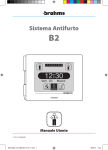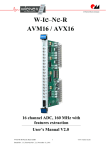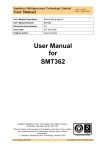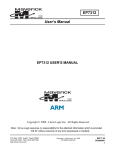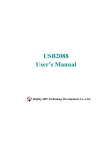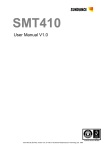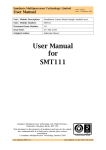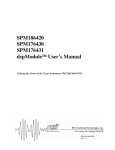Download SMT148 User Manual
Transcript
SMT148 User Manual Sundance Digital Signal Processing Inc 4790 Caughlin Parkway #233, Reno, NV 89509-0907, USA. Version 1.4 Page 2 of 35 SMT148 User Manual Revision History Date Comments Engineer Version 31/03/2004 First release PV 1.0 26/10/2004 Added power consumption GP 1.1 02/11/2004 Power connector part numbers clarified. GP 1.2 08/03/2006 Removed textual references to VP20 GP 1.3 30/08/2006 JTAG header pinout corrected SM 1.4 Version 1.4 Page 3 of 35 SMT148 User Manual Table of Contents Revision History.......................................................................................................... 2 List of abbreviations.................................................................................................... 5 Introduction................................................................................................................. 6 Overview ................................................................................................................. 6 Related Documents ................................................................................................ 6 General Description.................................................................................................... 7 Carrier block diagram.............................................................................................. 7 ComPorts interconnections ..................................................................................... 8 Global Bus connections ........................................................................................ 10 DAC circuitry ......................................................................................................... 10 ADC circuitry ......................................................................................................... 11 LVDS drivers/receivers ......................................................................................... 12 32-bit microcontrollers........................................................................................... 13 RS485 ................................................................................................................... 15 RSL ....................................................................................................................... 15 SHB ...................................................................................................................... 15 Power supplies...................................................................................................... 16 Power in ............................................................................................................ 16 Power Consumption .......................................................................................... 16 Power out .......................................................................................................... 17 JTAG..................................................................................................................... 17 LED ....................................................................................................................... 17 Fan Power............................................................................................................. 17 Reset Scheme ...................................................................................................... 17 IIOF Connectivity .................................................................................................. 18 FPGA configuration............................................................................................... 18 FPGA Firmware description...................................................................................... 19 Switch Fabric ........................................................................................................ 20 Input node (source) ........................................................................................... 21 Output node (destination) .................................................................................. 21 ComPorts (x8)....................................................................................................... 21 Source ............................................................................................................... 21 Destination ........................................................................................................ 22 Microcontroller ...................................................................................................... 23 Interface description .......................................................................................... 23 Source ............................................................................................................... 23 Destination ........................................................................................................ 24 Version 1.4 Page 4 of 35 SMT148 User Manual Polling interrupts................................................................................................ 24 Registers and address mapping........................................................................ 25 Watchdog timers ................................................................................................... 27 Reset..................................................................................................................... 27 DAC ...................................................................................................................... 28 ADC ...................................................................................................................... 29 LED ....................................................................................................................... 30 RSL ....................................................................................................................... 30 SHB ...................................................................................................................... 30 RS485 ................................................................................................................... 30 Global Bus and McBSP......................................................................................... 31 Verification Procedures ............................................................................................ 31 Review Procedures .................................................................................................. 31 PCB Layout Details .................................................................................................. 32 Connectors placement.............................................................................................. 33 Safety ....................................................................................................................... 33 EMC ......................................................................................................................... 33 Getting started with the SMT148 .............................................................................. 34 Connection to the host .......................................................................................... 34 JTAG connection ............................................................................................... 34 External ComPort cable..................................................................................... 34 SMT148 interconnection ....................................................................................... 34 Checking that the system is functional .................................................................. 34 Running your first application on the SMT148 ...................................................... 35 Updating the FPGA firmware or the microcontroller boot code................................. 35 Version 1.4 Page 5 of 35 List of abbreviations ADC DAC DSP EPROM FPGA JTAG LED LSB LVDS MSB RSL SDB SHB SPI TIM UART USB Analog to Digital Converter Digital to Analog Converter Digital Signal Processing Erasable Programmable Read-Only Memory Field Programmable Gate Array Join Test Action Group Light Emitting Diode Least Significant Bit(s) Low Voltage Differential Signaling Most Significant Bit(s) Rocket IO Sundance Link Sundance digital bus Sundance High-speed Bus Serial Peripheral Interface Texas Instrument Module Universal Asynchronous Receiver Transmitter Universal Serial Bus SMT148 User Manual Version 1.4 Page 6 of 35 SMT148 User Manual Introduction Overview The SMT148 is a four sites TIM carrier board with external interfaces Connectors are provided to interface to: • Analog inputs (x8) • Analog outputs (x8) • UART (RS485) • UART (RS232) (x2) • LVDS (56 pairs) • JTAG • RSL • SHB • RS485 (16 pairs) • USB (x2) • Firewire (1394b) (x2) • LED (x32) Related Documents Texas Instruments Module specification External Interface User Manual: this document gathers all the functionalities of the Sundance’s firmware implemented on DSP TIMs SMT118: Carrier with 3 Module sites and I/O facilities SMT180: Carrier with 8 Module sites Version 1.4 Page 7 of 35 General Description Carrier block diagram Figure 1: Carrier block diagram Interface ADC DAC UART LVDS RSL SHB RS485 USB Firewire LED TIM global bus connections TIM ComPorts XC2VP7 optional yes yes yes optional half, optional optional optional optional yes yes(20 pins) yes (4) Table 1 : Interfaces SMT148 User Manual Version 1.4 Page 8 of 35 SMT148 User Manual ComPorts interconnections The four TIM sites and the FPGA on the SMT148 carrier card can communicate through ComPorts. The following diagram shows the ComPort interconnections. Each TIM site has two ComPorts connected to the FPGA on the carrier. Figure 2 : ComPorts interconnection Version 1.4 Page 9 of 35 SMT148 User Manual The external ComPort_1 is accessible on a 26 Way connector (3M), which cable (SMT502) can be used to connect to a SMT310Q and download application from a PC. This connector has the following pin-out. 1 CSTRB 2 GND 3 CRDY 4 GND 5 CREQ 6 GND 7 CACK 8 GND 9 D0 10 D1 11 D2 12 D3 13 D4 14 D5 15 D6 16 D7 17 3.3V 18 GND 19 /RESETOUT 20 GND 21 /RESETIN 22 GND 23 NC 24 NC Table 2 : External ComPort_1 pinout External Comports 2, 3, 4 and 5 are routed to two SHB connectors (Samtec QSH030-01) to allow connection to another SMT148 carrier and its ComPorts. The pin-out is as follow: 1 5 9 13 17 21 25 29 33 37 41 45 49 53 57 CSTRB_CP2 D0__CP2 D4__CP2 NC CREQ_CP3 D2_CP3 D6_CP3 CSTRB_CP4 D0_CP4 D4_CP4 NC CREQ_CP5 D2_CP5 D6_CP5 NC 2 6 10 14 18 22 26 30 34 38 42 46 50 54 58 CRDY_CP2 D1_CP2 D5_CP2 NC CACK_CP3 D3_CP3 D7_CP3 CRDY_CP4 D1_CP4 D5_CP4 NC CACK_CP5 D3_CP5 D7_CP5 NC 3 7 11 15 19 23 27 31 35 39 43 47 51 55 59 CREQ_CP2 D2_CP2 D6_CP2 CSTRB_CP3 D0__CP3 D4_CP3 NC CREQ_CP4 D2_CP4 D6_CP4 CSTRB_CP5 D0_CP5 D4_CP5 NC NC Table 3 : External ComPorts 2-5 pinout 4 8 12 16 20 24 28 32 36 40 44 48 52 56 60 CACK_CP2 D3_CP2 D7_CP2 CRDY_CP3 D1_CP3 D5_CP3 NC CACK_CP4 D3_CP4 D7_CP4 CRDY_CP5 D1_CP5 D5_CP5 NC RESET Version 1.4 Page 10 of 35 SMT148 User Manual Global Bus connections Some of the Global bus signals from the TIM sites are connected point-to-point to the FPGA on the SMT148 carrier card. These 19-bit data communication links can be used for different purposes (McBSP, HPI, interrupts …) and any protocol could be implemented in order to meet specific requirements. The firmware in the FPGA will make use of these links to give more flexibility to the system and thus balance the data/control load on the carrier depending on the customer constraints. DAC circuitry The SMT148 comprises eight 16-bit low-speed DAC channels with a ±10V output voltage span (DAC7742, 200kSPS/channel max) and internal voltage reference. See firmware description for details about DAC control. Figure 3 : DAC circuitry Version 1.4 Page 11 of 35 SMT148 User Manual ADC circuitry Eight ADC channels (8x AD7899-1) with a 14-bit resolution and a ±10V voltage input span are available on the SMT148.The analog inputs can be sampled up to a rate of 400kHz. See firmware description for details about DAC control. Figure 4 : ADC circuitry Version 1.4 Page 12 of 35 SMT148 User Manual LVDS drivers/receivers 24 LVDS drivers and 24 LVDS receivers are fitted on the carrier card to convert LVDS signals from/to LVTTL signals. The connectors used for the LVDS signals are four straight NorComp 37-pin D Type (191-037-113-001). In the default carrier FPGA firmware implementation two McBSP connections coming from each TIM site are mapped per connector. GND Input/Output 20 GND 2 McBSP_CLKR_Tx_0+ I 21 McBSP_CLKR_Tx_0- 3 McBSP_FSR_Tx_0+ I 22 McBSP_FSR_Tx_0- 4 McBSP_DR_Tx_0+ I 23 McBSP_DR_Tx_0- 5 GND 1 24 GND 6 McBSP_CLKX_Tx_0+ O 25 McBSP_CLKX_Tx_0- 7 McBSP_FSX_Tx_0+ O 26 McBSP_FSX_Tx_0- 8 McBSP_DX_Tx_0+ O 27 McBSP_DX_Tx_0- 28 GND 9 GND 10 GND 11 GND 29 GND 12 McBSP_CLKR_Tx_1+ I 30 McBSP_CLKR_Tx_1- 13 McBSP_FSR_Tx_1+ I 31 McBSP_FSR_Tx_1- 14 McBSP_DR_Tx_1+ I 32 McBSP_DR_Tx_1- 15 GND 33 GND 16 McBSP_CLKX_Tx_1+ O 34 McBSP_CLKX_Tx_1- 17 McBSP_FSX_Tx_1+ O 35 McBSP_FSX_Tx_1- 18 McBSP_DX_Tx_1+ O 36 McBSP_DX_Tx_1- 19 GND 37 GND Table 4: LVDS pinout (default firmware) x refers to the TIM site number. Each LVDS input pair is terminated with a 100Ω resistor. The LVDS driver devices are enabled by a signal generated by the FPGA (TX_EN), each enable controls 2 McBSP ports (see firmware description). The digital isolators have their own 3.3V power supply with magnetic isolation. This 4.8Gb/s full duplex link (up to 100Mb/s per differential pair) can be used for different purposes that require LVDS on the external world for long distance communications. Data transfers and their associated protocol can be performed and specifically implemented to meet customers’ requirements (e.g. 4x McBSP channels, SPI interfaces, interrupts …). Figure 5 : LVDS circuitry Version 1.4 Page 13 of 35 SMT148 User Manual 32-bit microcontrollers The FPGA on the SMT148 carrier card is connected to two 32-bit microcontrollers (oxuf922) that enable communication with some of the most widely used standards: UART (RS485, RS232), USB, and Firewire (1394b). Data transfers and instructions can be set between the microcontrollers and the FPGA in both directions thus allowing the implementation of many different schemes. The flash device will hold the FPGA and microcontroller firmware. The 48MHz clock is required for the use of the USB. Each microcontroller will have the following interfaces. The second microcontroller interfaces only to a USB connector, RS232 and the FPGA. The microcontrollers are accessible through a JTAG connector (JP10). This is the only device in this chain. The pinout is as follow: 1 3.3V 2 TRST 3 TCK 4 TMS 5 TDO 6 TDI Table 5 : Microcontroller JTAG Figure 6 : Microcontroller interfaces (uC1, U65) A jumper (JP14) enables RS232 when inserted, RS485 when removed. Version 1.4 Page 14 of 35 1 DCD 2 Rx 3 Tx 4 DTR 5 GND 6 DSR 7 8 RTS CTS 9 RI SMT148 User Manual Table 6 : RS232 UART DB9 pinout The RS232 cable needs to be a Null Modem cable DB9 1 DCD+ 14 DCD- 2 Rx+ 15 Rx- 3 Tx+ 16 Tx- 4 DTR+ 17 DTR- 5 DSR+ 18 DSR- 6 19 7 RTS+ CTS+ 20 RTSCTS- 8 RI+ 21 RI- 9 GND Table 7 : RS485 UART DB25 pinout (all other pins are not connected) 1 USB_ind 2 Data- 3 Data+ 4 GND Table 8 : USB pinout 1 NC 2 GND 3 TPB- 4 TPB+ 5 TPA- 6 TPA+ Table 9 : Firewire pinout Version 1.4 Page 15 of 35 SMT148 User Manual RS485 16 bi-directional RS485 pairs are connected to the FPGA. Each byte direction is controlled by the firmware. The RS485 driver/receivers are connected to a SDB type connector (40 way). The connector pinout is as follow: Function S0S1S2S3S4S5S6S7GND GND pin 1 3 5 7 9 11 13 15 17 19 pin 2 4 6 8 10 12 14 16 18 20 Function S0+ S1+ S2+ S3+ S4+ S5+ S6+ S7+ GND GND Function GND GND S8S9S10S11S12S13S14S15- pin 21 23 25 27 29 31 33 35 37 39 pin 22 24 26 28 30 32 34 36 38 40 Function GND GND S8+ S9+ S10+ S11+ S12+ S13+ S14+ S15+ Table 10: RS485 pinout RSL A RSL link is available on the carrier and can allow users to transfer up to 20Gb/s of data in full duplex mode. This ultra high speed transfer link uses the dedicated Rocket IO from the Xilinx FPGA. Refer to RSL specifications and pinout for more details. SHB One 60-pin SHB connector (Samtec QSH-030-01) is connected to the FPGA. It can be used for debugging purposes and connected to a Logic Analyser using some specific adapters. It can also be used as a high speed link to transfer data to the FPGA carrier and TIM modules using the SDB protocol (2x 200Mbytes/s). For this configuration, please refer to SHB documentation. Version 1.4 Page 16 of 35 SMT148 User Manual Power supplies Power in Power is supplied from an external source. The voltage of the external source needs to be in the range +18V +30V. This enters the board via an 8-pin connector (JP6 on board, Receptacle, mini fit 8 Way, Molex 39-28-1083). +18-30V 1 +18-30V 2 +18-30V 3 +18-30V 4 GND 5 GND 6 GND 7 GND 8 Table 11 : Power in pinout The mating part to this connector is a Molex 39-01-2080 (Farnell order code 151-869 + 8 off 39-00-0039, Farnell 151-890). The external source is input to a DC-DC converter module, which produces +/-12V to the TIM sites. It is also used as an input to two DC-DC converters that produce the +5V, +3.3V, +2.5V and 1.5V supply to the TIM sites, carrier FPGA and other devices. Power Consumption The typical current consumption of an SMT148-LT would be 120mA at 24V. For an SMT148, this would be 280mA. These are actual measured values with no TIMs fitted. When TIMs are added, then the power consumption of the TIMs must be added to that of the SMT148/-LT with the SMT148 power supply efficiency taken into account (approximately 80%). Example: Power consumption of SMT148-LT only = 24*0.12 = 2.88W Power consumption of TIM, say 3.3V at 1A = 3.3W Total power consumption = 2.88 + 3.3/0.80 = 7.0W Version 1.4 Page 17 of 35 SMT148 User Manual Power out Power can be supplied to external devices or modules. The 8-pin connector (Receptacle, mini fit 8 Way, Molex), providing different voltages, has the following pinout: Pin number -12V 1 +12V 2 +5V 3 +3.3V 4 GND 5 GND 6 GND 7 GND 8 Table 12 : Power out pinout JTAG A single JTAG chain connects all 4 TIM sites and the JTAG in & out connectors. This chain is used with the TI Code Composer Studio software suite. The JTAG-out (JTAG2) connector can be connected to the JTAG-in (JTAG1) connector of other SMT148, thus extending the chain (see cable SMT503). LED A 8x4 array of LED is connected directly to the FPGA and is controlled by the FPGA firmware Fan Power Eight two-pin connectors are provided to supply fans with a +12V supply. Reset Scheme A power rail monitor observes the state of the 3.3V supply. This device will generate a reset to the SMT148 (RESET148) during power-up or if the 3.3V supply drops below 3V. This signal is an open-collector output and is also driven to the inter-card ComPort connector, and thus to another SMT148. The POR (power on reset) signal is driven to the RESETOUT pin on the external ComPort1 connector. The RESETIN pin on the above connector is buffered by an open-collector device which in turn can also drive the RESET148 signal. An additional 4 pin header is provided to allow other devices to share the open-collector RESET148 signal. The TIM reset pins are connected to the FPGA and will be reset when RESET148 is active as well as when some firmware conditions trigger a reset to the different TIMs (see Firmware description for more details about TIM reset). Version 1.4 Page 18 of 35 SMT148 User Manual IIOF Connectivity Each TIM site provides 3 interrupt pins, IIOF0, 1 & 2. IIOF0 & 1 are connected in a daisy-chain with TIM site 1 IIOF0 connected to TIM site 2 IIOF1; TIM site 2 IIOF0 connected to TIM site 3 IIOF1 finishing with TIM site 4 IIOF0 connected to TIM site 1 IIOF1. All TIM site’s IIOF2 signals are connected together. FPGA configuration In the default configuration the FPGA is configured by the microcontroller that fetches the configuration in the flash device. However it is possible to download a new configuration to the FPGA using the Xilinx JTAG cable connected to a PC and to JP5 on the SMT148 carrier. The pinout is as follow: 1 3.3V 2 GND 3 TMS 4 TCK 5 TDI 6 TDO Table 13 : FPGA configuration Version 1.4 Page 19 of 35 SMT148 User Manual FPGA Firmware description The FPGA Virtex II Pro on the SMT148 carrier card is connected to many different devices and therefore has many internal interfaces that allow it to exchange data or commands with the external world. All interfaces are reset at power on or when a manual reset is applied. The diagram below shows the interconnections between the digital modules inside the FPGA. Figure 7 : FPGA firmware Version 1.4 Page 20 of 35 SMT148 User Manual Switch Fabric Due to the high number of interfaces to be implemented in the firmware it is important to keep the design scalable and flexible. The switch fabric is a digital component that could be seen as a giant multiplexer/demultiplexer and that allows to dynamically connect the different interfaces to each others. The switch fabric will run on the FPGA system clock (100MHz by default) and will therefore not become the bottleneck for any transfer. It has multiple input nodes and output nodes operating under a protocol disregarding the specificities of the interfaces it is connected to. The node data/address bus is 8-bit wide plus few control signals. Any input node can target any output node but one input node can be remotely connected to only one output node at a time. When a transfer is about to be started by a specific interface (input node) the first word received on the switch fabric input node will be the address of the output node it needs to access. Three bytes of zeros will then be sent after the address byte. The data/address/control words that will follow will be sent to the output node and must comply with the specific format of the targeted interface. Output node ComPort_0 (TIM1) ComPort_1 (TIM1) ComPort_2 (TIM2) LED ComPort_4 (TIM3) DAC ComPort_6 (TIM4) μcontroller1 McBSP TIM1 McBSP TIM2 McBSP TIM3 McBSP TIM4 Watchdog timer TIM1 Watchdog timer TIM2 Watchdog timer TIM3 Watchdog timer TIM4 RS485 μcontroller2 RSL SHB ComPort_3 (TIM2) ComPort_5 (TIM2) ComPort_7 (TIM2) ADC Switch Fabric Address (Hex) 00 01 02 03 04 05 06 07 08 09 0A 0B 0C 0D 0E 0F 10 11 12 13 14 15 16 17 F0 Table 14 : Output nodes addresses Version 1.4 Page 21 of 35 SMT148 User Manual Input node (source) The input node is defined as being an input to the switch fabric. It runs on the FPGA system clock and has the following input and output signals. WE HOLD DATA input output input Write enable Receiver is full or already busy with another node, hold transfer 8-bit data bus Table 15: Input node IO Note that all transfers are made in burst of 4 words. Therefore the HOLD flag should be taken into account when the burst is completed. Output node (destination) The output node is an output from the switch fabric. It runs on the FPGA system clock and has the following input and output signals. WE FULL DATA DONE output input output input Write enable Receiver full, transmitter must hold transfer 8-bit data bus Transfer completed Table 16 : Output node IO The output node interface, depending on the settings and data it received, and detecting that the transfer is completed will assert a completion signal (DONE) to the switch fabric that will disable the connection between the two nodes. ComPorts (x8) The ComPorts interfaces are directly connected to the switch fabric and allow communication with external devices and modules using the ComPort or SDL protocol (please refer to the SDL Technical Specifications for more details). On the switch fabric side the ComPorts must comply with the input and output node descriptions. Source As an input to the switch fabric the ComPort interface can access any output resources (destinations) connected to the switch fabric. To enable the connection to a specific destination the ComPort interface must send the right address to the switch fabric and once connected can start streaming data and/or control to the output node. The ComPort source to the switch fabric also expects one 32-bit word before it can start sending data to the switch fabric: Bit 31: never ending transfer if 1. This setting can be useful when the connection needs to always be enabled such as the DSP is streaming data to the DAC via the ComPort without stopping. This bit must be set to 0 if the ComPort needs to be dynamically reconnected to another node at some stage. Bit 23 down to 0: transfer length. This is the total number of 32-bit words that will be sent to the ComPort interface (excluding this word). This gives a maximum transfer length of 2^26-4 bytes (64Mbytes). When the ComPort interface has received all data it expected, it will go in an idle state for 2us before starting a new transfer if instructed to do so. This setting is ignored if bit 31 is set to 1. Version 1.4 Page 22 of 35 SMT148 User Manual Destination Any input node to the switch fabric can access the ComPort interface. Please note that a ComPort is a bi-directional bus. However it is not possible to transfer data in both directions at the same time. Therefore, if some activity has been detected on the input path to the switch fabric, the output path, if accessed, will raise its full flag when it cannot accept data anymore (i.e., when its FIFO is full). The ComPort interface must first receive a 32-bit word of settings In order to be able to start transmitting the data it will receive. Bit 31: never ending transfer if 1. This setting can be useful when the connection needs to always be enabled such as the case the ADC streams its data to the same DSP via one of his ComPorts. This bit must be set to 0 if the ComPort needs to be dynamically reconnected to another node at some stage. Bit 23 down to 0: transfer length. This is the total number of 32-bit words that will be sent to the ComPort interface (excluding this word). This gives a maximum transfer length of 2^26-4 bytes (64Mbytes). When the ComPort interface has received all data it expected it will disconnect itself from the input node by sending a done pulse to the switch fabric. This setting is ignored if bit 31 is set to 1. Version 1.4 Page 23 of 35 SMT148 User Manual Microcontroller The microcontroller brings great flexibility to this carrier card by enabling USB, Firewire and UART (RS485/RS232) external communications. Its interface inside the FPGA is directly connected to the switch fabric and must therefore comply with the input node and output node descriptions. Interface description The microcontroller is connected to the FPGA on the carrier card with the following signals: DATA ADDRESS NWE NOE NCS2 input/output input input input input 8-bit data bus, bidirectional 12-bit address bus Write enable, active low Output enable, active low Chip select, active low The microcontroller is the master device and sees the FPGA as an addressable memory space. There is no interrupt signal available between the two devices and in order to catch any event the microcontroller will poll the interrupts from the FPGA regularly. Source As an input to the switch fabric the microcontroller interface can access any destination resource connected to the switch fabric. The microcontroller is able to convey data from a USB, Firewire or RS485/232 connection. When initiating a new transfer, the microcontroller should signal where the data are coming from, how much data there is and what the final destination for these data will be. The first 32-bit word expected by the interface contains information about the transfer type and the amount of data that need to be transferred to the switch fabric. This word needs to be sent to address h000 Bit 31: never ending transfer if 1. This setting can be useful when the connection needs to always be enabled such as the microcontroller is streaming data to the DAC without stopping. This bit must be set to 0 if the microcontroller interface needs to be dynamically reconnected to another node at some stage. Bit 29 down to 28: Transfer type, RS232=”00”, RS485=”01”, USB=”10”, Firewire=”11” Bit 25 down to 0: This is the total number of bytes that will be sent to the microcontroller interface (excluding this word). This gives a maximum transfer length of 2^26-1 bytes (64Mbytes). When the microcontroller interface has received all data it expected, it will go in an idle state for 2us before starting a new transfer if instructed to do so. This setting is ignored if bit 31 is set to 1. Please note that all nodes connected to the switch fabric transmit and receive information based on 32-bit words. All the remaining words part of this transfer will be sent to address h001. The second 32-bit word sent to the interface and passed to the switch fabric is the destination address (coded on the LSB, all other bytes must be set to 0). It can Version 1.4 Page 24 of 35 SMT148 User Manual happen that the microcontroller is not aware of the destination of the data it passes to the FPGA. If the address sent is 255 (hFF), the interface will fetch the value of a specific register that can be set by any resource in the system (see destination register). This register will contain the address of the destination and will be passed to the switch fabric if required. In RS232 and RS485 modes, only one byte (the 1st byte, LSB) of relevant data is transferred by 32-bit words. This has no implication on the firmware. However users who for example write a program to be executed on DSP TIM to receive or transmit data from/to the microcontroller should bear this in mind! Destination The microcontroller can be accessed by any resource connected to the switch fabric. It offers the option of streaming data over USB, Firewire, RS485 or RS232. The first 32-bit word this node will receive will describe the type of transfer it needs to perform as well as how much data will be transferred. Bit31: never ending transfer if 1. This bit must be set to 0 if the microcontroller interface needs to be dynamically reconnected to another node at some stage. Bit 30: must be 0 Bit 29 down to 28: Transfer type, RS232=”00”, RS485=”01”, USB=”10”, Firewire=”11” Bit 23 down to 0: This is the total number of 32-bit words that will be sent to the microcontroller interface (excluding this word). This gives a maximum transfer length of 2^26-4 bytes (64Mbytes). When the microcontroller interface has received all data it expected from the switch fabric it will disconnect itself automatically by sending a done pulse. Polling interrupts The microcontroller is a master over the FPGA. It needs to check regularly what the status of the different resources inside the microcontroller interface is. Note that a status request can be performed at any time during a transfer from the microcontroller to the interface. However a status request during an interface to microcontroller transfer can only be performed when a 32-bit word transfer is complete. Version 1.4 Page 25 of 35 SMT148 User Manual Registers and address mapping In addition to being written and read for data transfers, the microcontroller interface includes some registers that can be accessed or written by the microcontroller: Register/command Address (Hex) Settings write 000-003 Write data 004-007 Read data 008-00B Destination register (read) 00C-00F Destination register (write) 010-013 Status register (read) 014-017 Firmware revision number 018-01B RAM (read/write) 800-FFF Table 17 : Register addresses When ordered to read a register the interface inside the FPGA will then be given the bus and will shift out the required register to the microcontroller. Version 1.4 Page 26 of 35 SMT148 User Manual Status register Bit 29 down to 28: Transfer type to microcontroller RS232=”00”, RS485=”01”, USB=”10”, Firewire=”11” Bit 9: Busy signal, active high. It indicates that the data path to the switch fabric is busy with a transfer from the microcontroller. A new transfer from the microcontroller cannot be started until this signal has been de-asserted. Bit 8: FIFO to Switch Fabric almost full => the microcontroller should stop writing data to the interface and wait for this flag to be low again before continuing the transfer. Bit 7 down to 0: Number of words in the FIFO to the microcontroller (FIFO is 1024 words deep) => the microcontroller can start reading data with a maximum burst size of this number. Destination register This register contains the address of the destination connected to the switch fabric when the microcontroller does not know where to send the words it will transmit (i.e., when the microcontroller tries to access a node with address 255). The default value of this register is h40000000 (ComPort 0). This register can be written or read by the microcontroller using register addresses (Table 17). This register can also be written by any node connected to the switch fabric (e.g., ComPorts) when sending the following word to the microcontroller interface. Bit 30: must be 1 Bit 7 downto 0: Address of the destination node Firmware revision number The firmware revision number can be accessed by the microcontroller in order to check what are the version of the current firmware as well as the size of the FPGA. The firmware revision number is coded on 8 bits. Bit 31 down to 8: reserved Bit 7 down to 5: a, revision number “before comma” Bit 4 down to 2: b, revision number “after comma” Bit 1 down to 0: c, FPGA size , 00=> VP7 Version 1.4 Page 27 of 35 SMT148 User Manual Watchdog timers The watchdog timers are used for reset purposes by the different TIM modules in the system. Each TIM can access its own watchdog timer and set a time that will elapse before the TIM or all TIM modules are reset. The watchdog timer expects 4 words (of one byte each). The first byte received is the LSB; the fourth byte is the MSB. After receiving these four words the watchdog timer will send a DONE pulse to the switch fabric in order for the input node to be disconnected. The four bytes received by the watchdog timer accounts for a 32-bit word: Bit 29: All TIM reset if 1, only one TIM reset if 0. Bit 28 down to 0: number of clock cycles before reset. If this number has been set to 0, the watchdog timer is disabled. The watchdog timer can be programmed for 1 clock cycle (10ns) up to 2^29-1 cycles (5.3s). Each watchdog timer can be interrupted any time by writing 4 bytes of 0 to it. On the switch fabric side the watchdog timer is compliant to interface to an output node. The watchdog timer also interfaces to the reset circuitry with the following signals. GRESET TRESET Output Output Global reset to all TIM Reset one TIM only Table 18 : Watchdog timer extra IO Reset The reset circuitry inside the FPGA is connected to the watchdog timers. When it receives a GRESET pulse it will reset all TIM modules for 2^20 cycles (~10ms). When it receives a TRESET pulse it will reset one TIM module for 2^20 cycles (~10ms). The reset circuitry has the following inputs and outputs. GRESET1 GRESET2 GRESET3 GRESET4 TRESET1 TRESET2 TRESET3 TRESET4 nTIM1RESET nTIM2RESET nTIM3RESET nTIM4RESET input input input input input input input input output output output output Global reset to all TIMs from watchdog timer 1 Global reset to all TIMs from watchdog timer 2 Global reset to all TIMs from watchdog timer 3 Global reset to all TIMs from watchdog timer 4 Reset TIM 1 from watchdog timer 1 Reset TIM 2 from watchdog timer 2 Reset TIM 3 from watchdog timer 3 Reset TIM 4 from watchdog timer 4 TIM1 reset, active low TIM1 reset, active low TIM1 reset, active low TIM1 reset, active low Table 19 : Reset IO Version 1.4 Page 28 of 35 SMT148 User Manual DAC The DAC interface is only an output node to the switch fabric and it interfaces to the DAC device on the carrier card. All eight channels are controlled and updated by this interface. The DAC interface is a slave and will disconnect itself from the input node only if it receives the instruction to do so. To initialize a transfer or disconnect itself from the input node the DAC interface expects to receive the following 32-bit word (4 consecutive bytes, LSB first): Bit 31: new transfer initialization if 1. Bit 30: disconnect from input node if 1, will result in a DONE pulse sent to the switch fabric. Bit 15 down to 8: sampling ratio. The DAC devices are converting data from digital to analogue at a fixed rate of 200 KHz. However the user can reduce this converting rate by a factor determined by the sampling ratio value. Example: if sampling ratio = 8, the new conversion rate is 200KHz/8=25KHz. Sampling ratio=0 Ù Sampling ratio=1. Bit 7 down to 0: Channels enable, 1 on bit X indicates that channel X will be used, 0 that it will not. If the DAC interface received a new transfer initialization command, the next words will be interpreted as samples. One sample is coded on 4 bytes, LSB received first. Bit 31: must be 0 (otherwise interpreted as initialization) Bit 30: must be 0 (otherwise interpreted as disconnection) Bit 23 down to 16: channel to which the sample belongs, 1 on bit X indicates that the sample belongs to channel X-16. All the other bits must be set to 0. Bit 15 down to 0: sample value The DAC interface communicates to the DAC device on board using the following signals. Please refer to the DAC7742 datasheet for more details. RnW nCS nLDAC RSTSEL nRST nREFEN Data_to_dac output output output output output output output Read, not Write 8-bit chip select, active low, one nCS per channel Load DAC register to output, active low Tied to 1, output is half-scale code when DAC reset Reset, active low Enables internal +10V reference, active low 16-bit data bus Table 20 : DAC interface extra IO Version 1.4 Page 29 of 35 SMT148 User Manual ADC The ADC interface is an input as well as an output node to the switch fabric. All eight channels are controlled by this interface. It needs to receive settings before it can transmit digitized samples to the interface it was initialized by. To initialize a transfer or disconnect itself from the input node the ADC interface expects to receive the following 32-bit word (4 consecutive bytes, LSB first): Bit 31: new transfer initialization if 1. Bit 30: disconnect from input node if 1, will result in a DONE pulse sent to the switch fabric. Bit 23 down to 16: output node address to which the digitized samples will be sent to Bit 7 down to 0: Channels enable, 1 on bit X indicates that channel X will acquire data, 0 that it will not. After the ADC interface has been initialized it will start transmitting the digitized samples through the switch fabric to the specified output node. The first 32-bit word sent from the ADC interface to the switch fabric will address the output node it needs to access. Bit 31 down to 8: set to 0 Bit 7 down to 0: output node address (see table 14) The next words sent to the switch fabric will have the following format: Bit 31 down to 24: time stamp. This value is incremented by one every time a new sample is available on a specific channel. If the receiver detects that 2 samples from the same channel received consecutively have a time stamp difference not equal to one, this means that some samples have been lost during transfer. Bit 23 down to 16: channel to which the sample belongs, 1 on bit X indicates that the sample belongs to channel X-16. All the other bits will be set to 0. Bit 13 down to 0 : digitized sample value. The ADC interface communicates with the ADC device on board using the following signals. Please refer to the AD7899 datasheet for more details. nRD nCS nCONVST CLKIN BUSY nSTBY DATA_in Output Output Output Output Input Output Input Read, active low Chip select, active low Convert start analog input, active low Conversion Clock Conversion is in progress Standby, active low 14-bit data bus Table 21 : ADC interface extra IO Version 1.4 Page 30 of 35 SMT148 User Manual LED The LED interface is only a slave output node and turns on or off the 32 LED on the carrier depending on the settings it receives. The LED interface expects only one 32bit word and will disconnect itself automatically from the input node after it received it (meaning that a DONE pulse is sent to the switch fabric). Bit 8: indicate the LED value, on if 1, off if 0. Bit 4 down to 0: LED address. RSL The RSL interface is compliant to the Sundance RSL specifications. A fast bidirectional data pipe can be connected between the RSL interface and the SHB interface for data conversion from one to the other. SHB The SHB interface is compliant to the Sundance SHB specifications and protocol. RS485 The RS485 interface is an output node as well as an input node to the switch fabric. The first 32-bit word received by this interface defines the transfer direction of the 2 bytes connected to RS485 transceivers on the carrier board. It also defines the length of the transfer for both bytes and the address of the output node (in the case one of the bytes is set as an output). Bit 31 0 0 1 1 Bit30 0 1 0 1 Byte 1 (bit 15 down to 8) Output Output Input Input Byte 0 (bit 7 down to 0) Output Input Output Input Table 22 : RS485 settings Bit 29 down to 16: Bytes transfer length (if length=0, the transfer will never end) Bit 7 down to 0 : Output node address in the case one or both bytes are set as an input to the system. On the FPGA IO side, in addition to the 2 bytes, 2 signals controlled by the settings allow to set the transceivers directions on the carrier. Version 1.4 Page 31 of 35 SMT148 User Manual Global Bus and McBSP In the current version of the firmware the global bus and McBSP interfaces are directly connected to each other to allow direct McBSP channels connections between the different TIM sites and the external world. However in a future revision of the firmware both interfaces could also be connected to the switch fabric in order to increase flexibility. The current firmware allows the user to enable or disable the McBSP channels. Each receiving or transmitting channel per TIM can be controlled by the DSP user program. The receiving signals will be enabled or disabled inside the FPGA whereas this is done directly on the LVDS drivers for the transmitting signals. This interface expects to receive a single 32-bit word that will determine the ‘on’ or ‘off’ status of the McBSP channels. After receiving the 32-bit word it will disconnect itself automatically from the input node by sending a DONE pulse to the switch fabric. Bit 25: McBSP channel 1 transmitter enabled if 1, disabled if 0. This setting is ignored if bit 24 is set to 0. Bit 24: McBSP channel 1 transmitter selected if 1. Bit 17: McBSP channel 1 receiver enabled if 1, disabled if 0. This setting is ignored if bit 16 is set to 0. Bit 16: McBSP channel 1 receiver selected if 1. Bit 9: McBSP channel 0 transmitter enabled if 1, disabled if 0. This setting is ignored if bit 8 is set to 0. Bit 8: McBSP channel 0 transmitter selected if 1. Bit 1: McBSP channel 0 receiver enabled if 1, disabled if 0. This setting is ignored if bit 0 is set to 0. Bit 0: McBSP channel 0 receiver selected if 1. Verification Procedures The specification (design requirements) will be tested using the following: 1) Running Code Composer Studio 2) Test Program Review Procedures Reviews will be carried out as indicated in design quality document QCF14 and in accordance with Sundance’s ISO9000 procedures. Version 1.4 Page 32 of 35 SMT148 User Manual PCB Layout Details The SMT148 dimensions are as follow: 200mmx250mm (7.87’ x 9.84’). The following picture shows the component placement on the PCB. Figure 8 : PCB layout details Version 1.4 Page 33 of 35 SMT148 User Manual Connectors placement Safety This module presents no hazard to the user. EMC This module is designed to operate from within an enclosed host system, which is build to provide EMC shielding. Operation within the EU EMC guidelines is not guaranteed unless it is installed within an adequate host system. This module is protected from damage by fast voltage transients originating from outside the host system which may be introduced through the output cables. Short circuiting any output to ground does not cause the host PC system to lock up or reboot. Version 1.4 Page 34 of 35 SMT148 User Manual Getting started with the SMT148 Please note that information regarding Power connections and interfaces is not outlined in this section of the document. For more details, please refer to the relevant paragraphs of this document. Connection to the host JTAG connection If you wish to run Code Composer Studio and have access to any DSP present in your embedded SMT148 system, you are required to connect a JTAG cable (combination of SMT508-XDS and SMT501-JTAG) between the SMT148 (JTAG1) and the JTAG connector on the front panel of the carrier card hosted in a PC. An alternative solution for users who wish to run the JTAG chain from a laptop is to use a PCMCIA JTAG module (SMT107-XDS) connected to the SMT148. External ComPort cable 3L Diamond users, in order to interact with the embedded system for development purposes, will require to use an external ComPort cable (SMT502 Embedded) connected between the SMT148 (connector JP4) and a carrier card hosted in a PC. On the PC side the ComPort cable plugs into the front panel ComPort connector of the carrier card. This cable is also required for running the Confidence Test. SMT148 interconnection Two SMT148 embedded carrier cards can be cascaded and thus creating an embedded system with up to 8 TIM sites and double the number of interfaces. The JTAG chain between the two carriers can be enabled by connecting a cable between JTAG2 of the first SMT148 to JTAG1 of the second SMT148. 3L Diamond users can also enable a ComPort link between both carriers using an SHB cable (SMT511) between JP1 of the first carrier card to JP2 of the second carrier card. Checking that the system is functional A DSP Sundance TIM (SMT365, SMT376, SMT374, …) is required to check that the ComPort link between the SMT148 and the host is properly enabled. This DSP TIM needs to be fitted on TIM Site 1 of the SMT148 to access the external ComPort 1 connected to JP4. The user should then open the SMTBoardInfo (SMT6300) program and launch the Confidence Test (Tools menu). If the test fails, please check the ComPort switch settings (Tools Menu) and make sure that the External Buffered ComPort is enabled. Version 1.4 Page 35 of 35 SMT148 User Manual Running your first application on the SMT148 A DSP module fitted on Site 1 of the SMT148 is necessary to run any application. The SMT148 you received has been delivered with an example of 3L Diamond application that accesses some of the interfaces on the SMT148. In addition to the application, the application source file (test.c) is available in the 3L folder and can be modified by users at their convenience. The example provided shows how the different resources on the carrier card can be accessed. The settings for the different interfaces have been directly derived from this document’s firmware description section. In order to recompile the source file, open a command prompt in the same folder and type ‘nmake’ to generate a new .app file that can be run in the 3L Diamond server. Make sure the TIM type in the ‘.cfg’ file matches with the TIM in your system. Please, not that 3L Diamond requires a compatible version of Code Composer Studio to be installed on the same PC. Extra information you might require for 3L Diamond functions as well as TIM types can be found in the 3L Diamond User Guide. Technical specifications and user guides for the different Sundance TIM modules and carrier cards can be downloaded directly from www.sundance.com. The Sundance Wizard Help file is also a great source for pertinent and precise information about Sundance hardware, software and systems. Updating the FPGA firmware or the microcontroller boot code Refer to the SMT148 microcontroller application note for updating the FPGA or the microcontroller firmware.






































